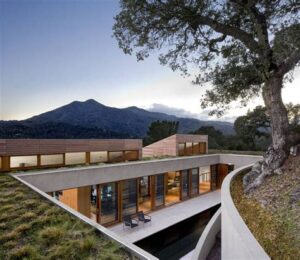Explore the advantages and challenges of hillside construction, design considerations, building materials, and environmental impacts for hillside homes.Building a home into the side of a hill is a unique architectural choice that offers a variety of benefits and challenges. This innovative design not only takes advantage of stunning views and natural landscapes but also allows for enhanced energy efficiency and integration with the surrounding environment. However, constructing a hillside home comes with its own set of complexities, from navigating the terrain to addressing drainage concerns. In this blog post, we will explore the advantages of hillside construction, the inherent challenges it presents, and the design considerations necessary to create a functional and aesthetic living space. Additionally, we will examine the building materials ideal for these projects and discuss the environmental impact of hillside housing. Whether you’re dreaming of a cozy retreat or a modern masterpiece, this guide will provide invaluable insights into hillside living.
Advantages of Building into a Hillside
Building a house into the side of a hill offers several advantages that can greatly enhance both living conditions and aesthetic appeal. One of the foremost benefits is the ability to take advantage of breathtaking views. When positioned on a hillside, homeowners have the opportunity to enjoy panoramic landscapes, whether it be lush forests, sparkling lakes, or stunning valleys.
Another significant advantage is the natural insulation provided by the earth. Homes built into hills benefit from a stable temperature throughout the year. This means that during hot summer months, the house remains cool, and in winter, it retains heat, reducing reliance on heating and cooling systems and ultimately saving on energy costs.
Furthermore, hillside homes often incorporate unique architectural designs that can blend harmoniously with the natural environment. The use of large windows, open spaces, and multi-level layouts can create an inviting atmosphere. This design philosophy promotes a strong connection between indoor living spaces and the surroundin
Challenges of Hillside Construction
Building a house into the side of a hill presents a unique set of challenges that must be carefully considered. Initially, one of the most significant difficulties is dealing with soil stability. The incline of the land can make the foundation process complicated, as soil erosion and landslides are common concerns. Proper geotechnical analysis is imperative to ensure the soil can support the weight of the structure.
Another challenge in hillside construction is accessibility. Often, these locations may be difficult to reach with standard construction vehicles and equipment. This limitation can increase the complexity and cost of logistics during the building process. Sometimes, it may require special equipment or the construction of temporary accesses to transport materials and labor to the site.
Lastly, there is the issue of regulatory compliance. Many hillside areas are subject to strict building codes and zoning laws, particularly when it comes to environmental protections and wildlife preservation. Obtaining necessary permits and adhering to these regulations can be time-consuming and challenging for builders. It’s essential to collabo
Design Considerations for Hillside Homes
When it comes to designing a hillside home, several considerations must be taken into account to ensure both safety and aesthetic appeal. The unique landscape and slope of the land can present both opportunities and challenges that need to be carefully navigated during the planning and construction phases. Below are some key factors to consider:
- Topography: The slope and orientation of the hillside will greatly influence the design. Architects must assess how the lay of the land will impact the foundation, drainage, and overall layout of the home.
- Site Drainage: Proper drainage systems must be implemented to manage water runoff. Without adequate drainage, soil erosion and water damage can occur, potentially jeopardizing the integrity of the structure.
- Access and Parking: Consider how to facilitate accessibility to the home. Driveways and pathways may need to be designed with gentle inclines to ensure safe and convenient entry for residents and visitors.
- Structural Support: Hillside homes require robust foundation systems due to the gravitational forces at play. Techniques such as pier and beam construction may be employed to ensure stability.
- Environmental Impact: It’s crucial to consider how the development of a hillside home will affect the surrounding ecosystem. Minimizing disruption to the natural environment and using sustainable materials should be a primary focus.
Incorporating these design considerations can lead to the successful development of a hillside home that not only blends seamlessly with its surroundings but also stands the test of time. By addressing structural, environmental, and aesthetic elements, homeowners can create spaces that are both functional and beautiful.
Moreover, it is essential to work with experienced architects and builders familiar with hillside construction. Their expertise will help address specific challenges and ensure that your dream home is built to the highest standards of safety and design.
Ultimately, the design of a hillside home should reflect the unique characteristics of its location while also fulfilling the practical needs of its inhabitants. Thoughtful planning and consideration will lea
Building Materials for Hillside Construction
Constructing a house on the side of a hill presents unique challenges, but with the right building materials, these challenges can be effectively managed. The choice of materials significantly impacts both the structural integrity and the aesthetic appeal of the hillside home.
One of the primary considerations in hillside construction is the need for materials that can withstand slopes and potential erosion. Here are some key materials typically used in such projects:
| Material | Advantages |
|---|---|
| Concrete | Offers excellent strength and durability; ideal for retaining walls. |
| Steel | Provides high tensile strength; resistant to seismic activity. |
| Wood | Lightweight and flexible; allows for innovative design. |
| Stone | Natural appearance that blends with the landscape; exceptional durability. |
Additionally, it’s crucial to consider the environmental impact of the materials used. Sustainable options, such as recycled materials, can minimize the ecological footprint of your hillside home without sacrificing quality. Incorporating green building practices is essential for maintaining harmony with the surrounding environment
Environmental Impact of Hillside Housing
Building homes into the side of a hill can have significant environmental impacts. While these structures often blend beautifully with the landscape, their construction must be carefully planned to mitigate adverse effects. One of the primary concerns is soil erosion. The removal of vegetation and alteration of natural drainage patterns can lead to increased runoff and soil instability.
Moreover, the construction of hillside homes can disrupt local ecosystems. Flora and fauna can be displaced, affecting biodiversity. It is essential for builders to conduct thorough environmental assessments prior to construction to identify and minimize impacts on wildlife habitats. Furthermore, the placement of homes should consider existing water drainage systems to avoid flooding and other water management issues.
Another critical aspect is the energy efficiency of hillside homes. Designs that take advantage of natural terrain can reduce reliance on artificial heating and cooling methods, thus lowering carbon footprints. Thoughtful architectural planning can enhance passive solar heating and improve overall sustainability. Engaging environmentally friendly materials and construction techniques can also lessen t
Frequently Asked Questions
What are the benefits of building a house into the side of a hill?
Building a house into the side of a hill can offer numerous benefits, including natural insulation, reduced energy costs, and stunning views. The earth surrounding the home can help maintain a more stable indoor temperature, while the elevated position can provide breathtaking vistas.
How do hillside homes handle drainage and water runoff?
Hillside homes typically incorporate specialized drainage systems to manage water runoff effectively. This often includes proper grading, gutters, and drainage pipes to redirect water away from the foundation, reducing the risk of erosion and water damage.
What architectural styles are common for hillside homes?
Hillside homes can feature a variety of architectural styles, including modern, contemporary, and rustic designs. Many incorporate large windows and open spaces to maximize natural light and enhance views, while others might use traditional materials and designs to blend into the natural landscape.
What are some design considerations for building into a hillside?
When designing a hillside home, considerations include structural stability, access (driveways and paths), and how the home will interact with its environment. Architects must also think about zoning regulations, wind patterns, and how sunlight will affect the home throughout the day.
Are there specific materials that work best for hillside construction?
Hillside construction often utilizes materials that are strong and durable, such as concrete, stone, and steel. These materials can provide the necessary structural support for the home while also withstanding the challenges posed by the landscape.
What challenges do homeowners face when building on a hillside?
Homeowners may face several challenges when building on a hillside, including higher construction costs, the need for specialized engineering, and potential land stability issues. Additionally, obtaining permits and conducting geological surveys may be necessary prior to construction.
Can building into a hill help with energy efficiency?
Yes, building into a hill can significantly enhance energy efficiency. The natural earth surrounding the home provides insulation, reducing heating and cooling needs. Furthermore, the orientation of the house can leverage passive solar heating, making it more environmentally friendly.





